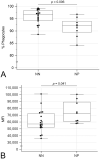Oxidative burst and phagocytic activity of phagocytes in canine parvoviral enteritis
- PMID: 34148453
- PMCID: PMC8366246
- DOI: 10.1177/10406387211025513
Oxidative burst and phagocytic activity of phagocytes in canine parvoviral enteritis
Abstract
Canine parvoviral enteritis (CPE) is a severe disease characterized by systemic inflammation and immunosuppression. The function of circulating phagocytes (neutrophils and monocytes) in affected dogs has not been fully investigated. We characterized the functional capacity of canine phagocytes in CPE by determining their oxidative burst and phagocytic activities using flow cytometry. Blood was collected from 28 dogs with CPE and 11 healthy, age-matched, control dogs. Oxidative burst activity was assessed by stimulating phagocytes with opsonized Escherichia coli or phorbol 12-myristate 13-acetate (PMA) and measuring the percentage of phagocytes producing reactive oxygen species and the magnitude of this production. Phagocytosis was measured by incubating phagocytes with opsonized E. coli and measuring the percentage of phagocytes containing E. coli and the number of bacteria per cell. Complete blood counts and serum C-reactive protein (CRP) concentrations were also determined. Serum CRP concentration was negatively and positively correlated with segmented and band neutrophil concentrations, respectively. Overall, no differences in phagocyte function were found between dogs with CPE and healthy control dogs. However, infected dogs with neutropenia or circulating band neutrophils had decreased PMA-stimulated oxidative burst activity compared to healthy controls. Additionally, CPE dogs with neutropenia or circulating band neutrophils had decreased PMA- and E. coli-stimulated oxidative burst activity and decreased phagocytosis of E. coli compared to CPE dogs without neutropenia or band neutrophils. We conclude that phagocytes have decreased oxidative burst and phagocytic activity in neutropenic CPE dogs and in CPE dogs with circulating band neutrophils.
Keywords: dogs; flow cytometry; inflammation; phagocyte; phagocytosis; respiratory burst.
Conflict of interest statement
Figures






References
-
- Ahmad M, et al.. In vivo effect of recombinant human granulocyte colony-stimulating factor on phagocytic function and oxidative burst activity in septic neutropenic neonates. Biol Neonate 2004;86:48–54. - PubMed
-
- Allison LN, et al.. Immune function and serum vitamin D in shelter dogs: a case-control study. Vet J 2020;261:1–8. - PubMed
-
- Bardoel BW, et al.. The balancing act of neutrophils. Cell Host Microbe 2014;15:526–536. - PubMed
-
- Bhan C, et al.. Role of cellular events in the pathophysiology of sepsis. Inflamm Res 2016;65:853–868. - PubMed
-
- Biswas SK, et al.. Endotoxin tolerance: new mechanisms, molecules and clinical significance. Trends Immunol 2009;30:475–487. - PubMed
MeSH terms
LinkOut - more resources
Full Text Sources
Research Materials
Miscellaneous

